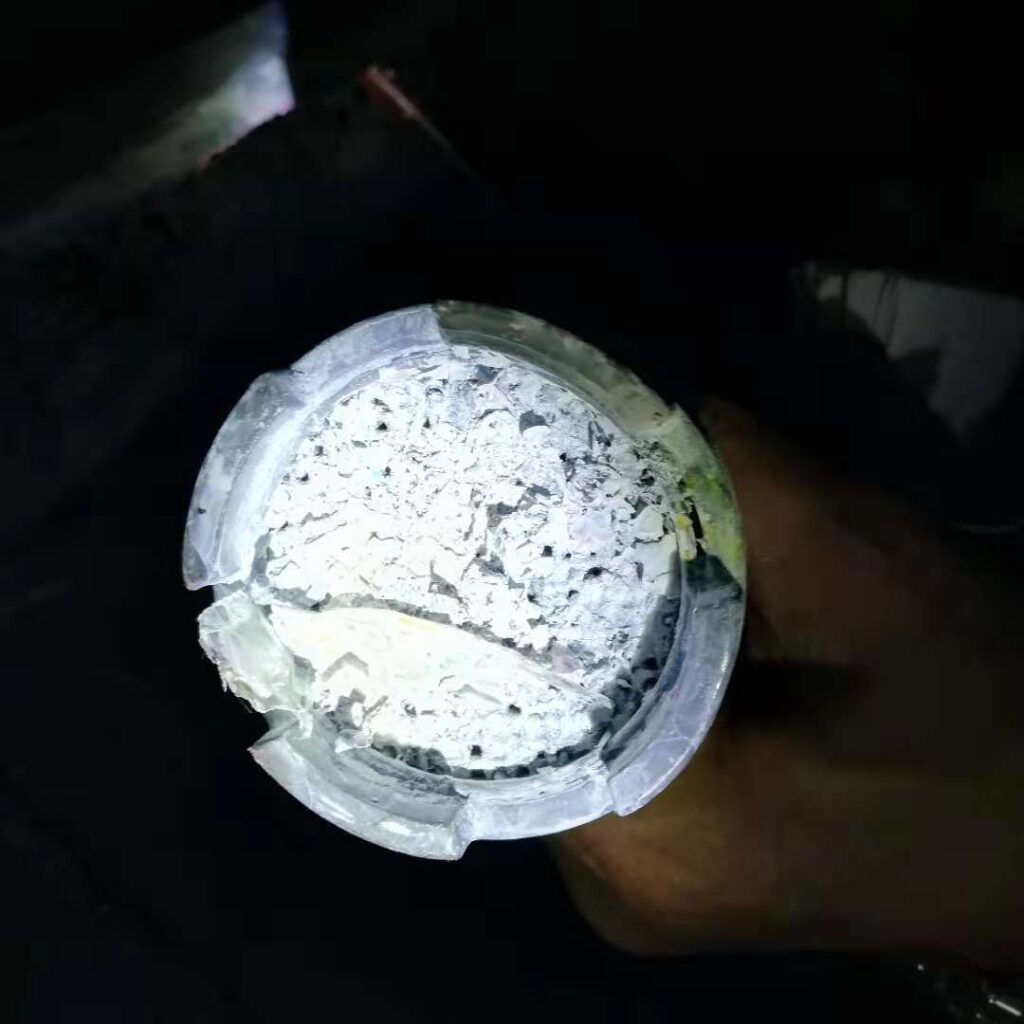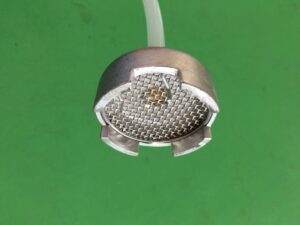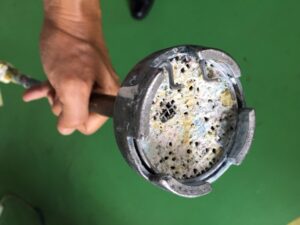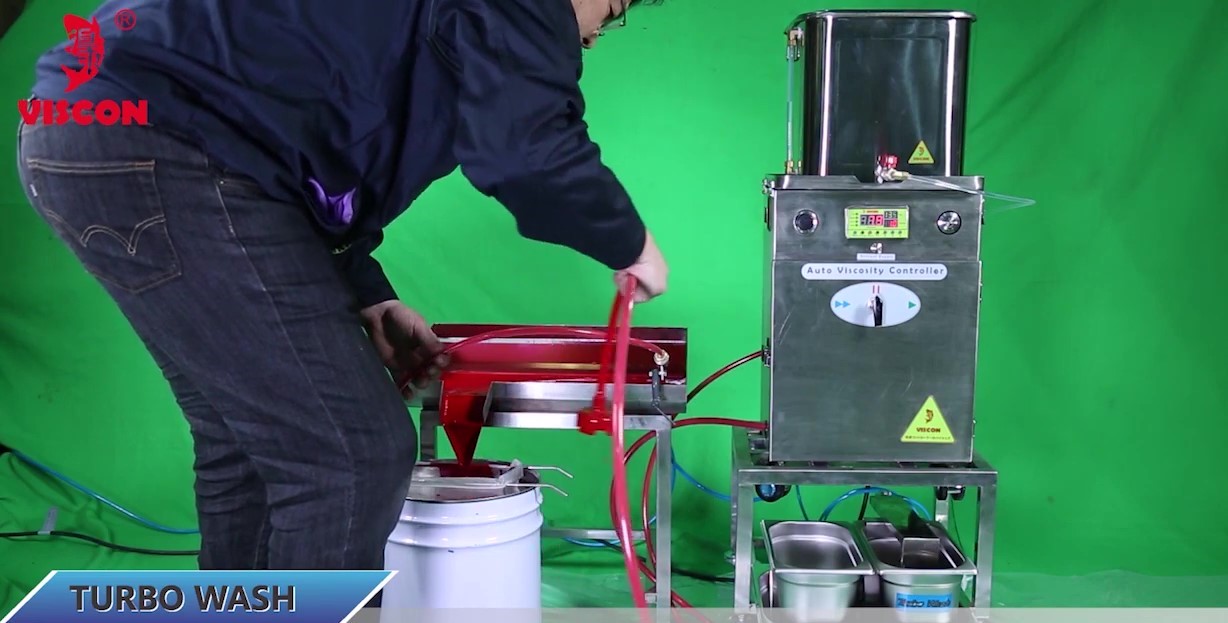Doc. 2 : Three major failure causes of conventional viscosity controllers
Elucidating three causes of failure from the repair experience of
conventional viscosity controllers


The wire mesh of the suction strainer is not visible. Cleaning is consequently insufficient. In this state where cleaning is insufficient, the viscosity accuracy is also poor because the ink cannot be sufficiently absorbed. Since the amount of ink discharge is also small, agitation is also bad and proper viscosity management is not possible. It can be easily expected that the inked dregs is attached to the pump. It is a sign one step before the failure of the viscsoity controller. Viscon Japan viscosity controller patented technology “TURBO WASH” strong bubble cleaning solves such cleaning shortage immediately.
I worked for 12 years (2003-2014) at my previous working company.
The photo above is related to my first viscosity controller checking work
at my overseas customers’ gravure printing and dry lamination factories.
Speaking of which, as you can see in the photo above,
I had to see and check the condition of the suction strainer
attached to suction hose of the viscosity controller.
Check conditions of suction strainer is the first step of diagnosis for
・ diagnosing the accuracy of the viscosity controller,
・the failure of the viscosity controller,
・the durability of the viscosity controller, etc.
If I describe in an extrem manner, if you look at the state here,
you might be guessing about the usage of the viscosity controller
used by the user and the problem of the viscosity controller.
Of course, it is also well versed in the principle of viscosity controllers,
and has been diagnosed with Viscon’s many years of experience
diagnosing the usage of viscosity controllers for many users in users
factories.

This suction strainer is submerged in an ink tank in each printing unit
of the gravure printing press on the side, ink is sucked from the
suction strainer, and ink is pumped through the diaphragm pump
in the viscosity controller through the delivery hose into the ink tray
of the printing unit.
What is the condition of the suction strainer I pulled from the ink tank ?
Ink and ink dregs are attached, and the wire mesh of the suction strainer
of the viscosity controller is not visible.
Gaps and meshes in the wire mesh are blocked.
This does not make the viscosity controller suck ink smoothly.
The state of the original suction strainer.
Wire mesh is also visible, there is a gap,
and the viscosity controller can suck ink smoothly.
This photo is the viscosity controller suction strainer in a new state,
but if you wash it with turbo wash, a powerful bubble washing method
provided by Viscon Japan viscosity controller,
the suction strainer is always close to this state( clean ).
The amount ( quantity) of ink delivery does not decrease.
Therefore, the accuracy of the viscosity controller is always high accuracy.

If the viscosity controller used by the user is always like this,
and the wire mesh of the suction strainer is also clearly seen,
it is very excellent !! Your viscosity controller diaphragm pump
can suck ink smoothly.
If the diaphragm pump of viscosity controller can suck the
ink in this state, the accuracy of the viscosity controller is accurate.

There are a lot of them, really. In this way, the wire mesh of the suction strainer of the viscosity controller
is clogged, and the viscosity controller that can not suck ink smoothly.
However, more than 80% of the wire meshes I see at my overseas customers
were not visible, as in the picture at the above and top.
(About 40% of half of them had lost their wire mesh.)
This is an even bigger problem.
We are going straight along the path of failure of the viscosity controller.
More importantly, a breakdown is a stage of surgery by being admitted
to a hospital if it is said that it is a human being.
Speaking of human beings, before the hospital hospitalization surgery,
the health condition has already continued from health to bad condition
by then, and then it is admitted to the hospital.
Speaking of viscosity controllers,
Breakdown/Failure = hospitalization and surgery
before Breakdown = The accuracy of the viscosity controller is already
getting worse every day. )
This means that the accuracy of the viscosity controller before failure/breakdown
is also inaccurate and not good.
Then, it is a viscosity controller that does not fulfill the purpose of the user
who is trying to print high quality.
This article of blog clearly explains the causes of the three major failures
of conventional viscosity controllers that are very troubled by the user’s head.
Individual reasons?
Does that lead to a viscosity controller failure?
Those will be discussed in a separate article of this blog later.
(I think this is the biggest advantage of a blog that can be updated
at any time, as it is a homepage that can not be updated frequently.
However, can I seriously update it?
There is also a problem. Wry smile)
So, first of all, I am familiar with the principle of viscosity controller,
and I will introduce the three major failure causes of viscosity controllers
that Viscon (Japan) Corporation analyzed and arranged
from many years of repair experience so long.
Click on the link below.
Open the PDF of the three major failure/breakdown causes of
the viscosity controller on a separate page.
👉 👉 3 Major Causes of Viscosity Controller Failure/breakdown
If any questions or unclear things,
please do not hesitate to contact us Viscon Japan Corporation. 👇 👇






コメント